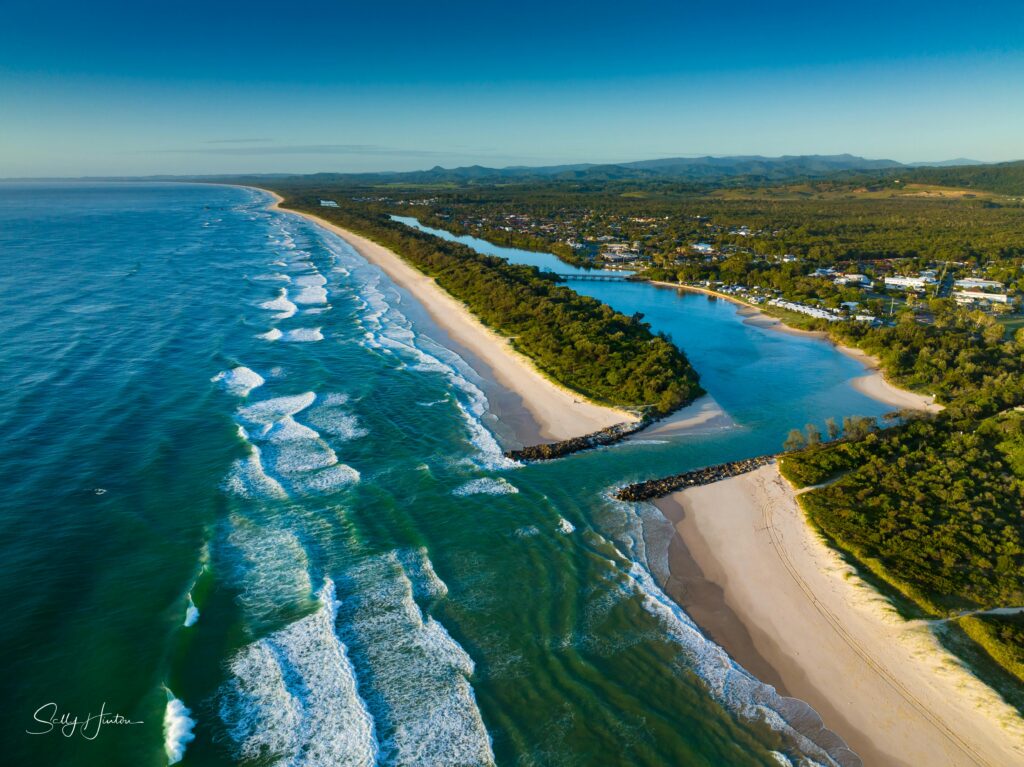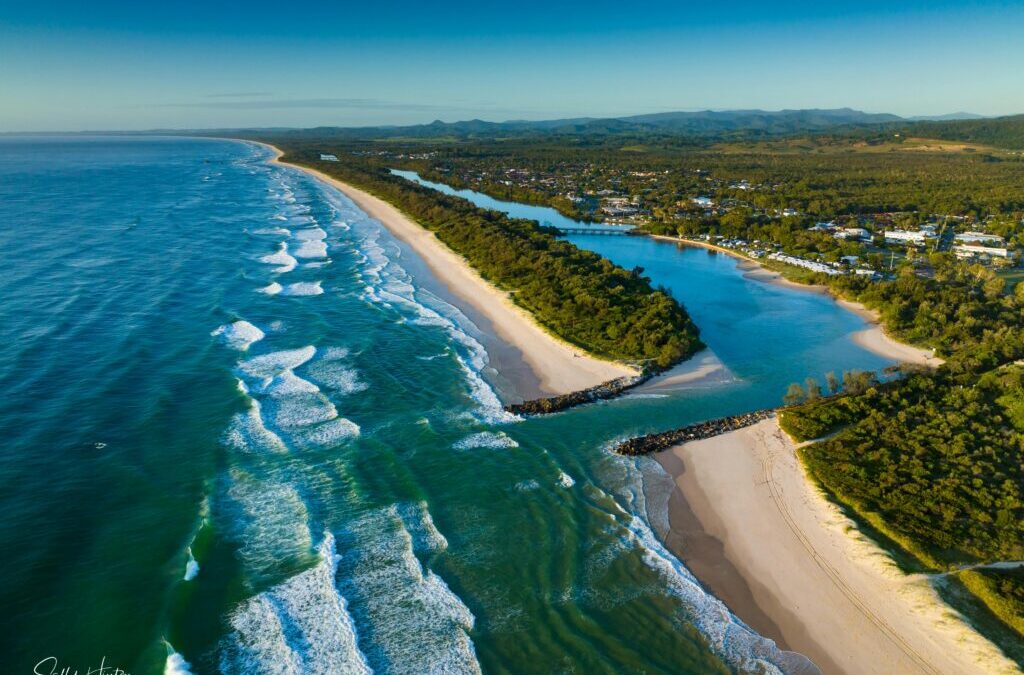Kindly Contributed by Pottsville’s own Tom Gardiner (Photo Sally Hinton)
In the beginning, the town that we now call Pottsville, was and still is, within the lands of the Bundjalung Nation.
The legend of the three brothers, Mommom, Yaburang and Burrung details how, Berrung, travelled north along the coast from present day Ballina to beyond the Brunswick River. The region between Brunswick Heads and the Tweed River and west towards Dunbible were occupied by the ‘Coodjinburra’ clan named after the red ochres that they would extract from local soils for their ceremonies.
The tribes of the coast were reported as being far less migratory than other inland clans due to the abundant sources of food such as possum, wallaby, snakes, bandicoots, flying foxes, multiple birds, fish types and shellfish. Travel between the coastal clans between Tweed and Ballina tended to be less confrontational because of this naturally abundant pantry.
They spoke a dialect of the Ngandowal language with the ‘Minyunbal’ being recorded as the most widely used dialect between Southport to Broken Head.
The first recorded white man in the area was John Oxley who had travelled from Fingal up the Tweed River for several kilometres in 1823.
Reports and observations of the ‘First Nations People’ were infrequently reported by explorers, public servants and police officers of the time due to the relative isolation of the Pottsville area and their cultural indifference. It was not until 1920 that Archibald Stanley (aka Snowy or Bill) Potts took up initially 26 acres, then another 28 acres between the present Pottsville and Hastings Point. May, his wife, named their house overlooking the creek – ‘Elanora’.
The area became known as ‘Potts Point’ but due to ongoing confusion with Sydney suburb of that name a new name was required. After some discussion in 1945 the area became officially know as ‘Pottsville’ largely due to the lobbying of the local Lower Cudgera Secretary, Frank Overall over the choice of ‘Lower Cudgera’ by the district Postal Inspector. His decision was recorded as not being popular with the locals! Snowy was queried as to why he had invested so much in what seemed like ‘useless land’ but he had a vision of a township sited within the land he had learned to love. That vision ultimately became the Far North Coastal NSW town of “Pottsville’.
Development came slowly through the local area for many decades but eventually families like Charles Dawes Family , Arthur Jones family and then the pioneering Hardy family all became neighbours.
Farmers were producing products such as cream, beef cattle, and small crops The Murnane’s had a local farm as well as did Berkley Harrison on 140 acres (situated near today’s Anglican Church. Berkley, was thought to be exiled from his homeland of England, despite being a well educated ‘Fellow of the Royal Horticultural Society.’
Late in the 1920’s Ernie Graham opened a store on the corner of Cudgera and Mooball Roads. General supplies could be obtained but more substantial needs and agricultural supplies need to be ordered in from bigger towns such as W.H Wilson’s store at Burringbar.
Another very influential pioneer of Pottsville was Albert Maxwell Francis (Frank) Overall who after managing a sheep property near Mooball and cutting cane at Crabbes Creek moved to a new homestead at Sleepy Hollow to grow bananas.
Frank was extremely civic minded and lobbied heavily for a quality road to be built between Pottsville and Kingscliff. Along with Jack Morley, a major retailer from Tweed, joining in the campaign they were ultimately only successful because of the emergence of the powerful Tweed Coast sand mining industry which had come to the immediate coastal settlements largely in response to the needs of the military in the Second World War. Later, in 1962 a ‘tourist road’ was proposed to link Pottsville to Wooyung to New Brighton. There were visions of this being a shorter (10km) potential Pacific Highway rather than the rugged, winding and steep Burringbar Range route. Whilst a gravelled road was eventually built, largely due to an $18000 from two sand mining companies (Cudgen RZ and Associated Minerals) seeking better access to the beach sand holdings the road eventually became overgrown and deteriorated before finally being largely abandoned.
This closure and non-development probably prevented Pottsville from becoming a more vaunted tourist destination and developmental township until much later. Ironically, it also helped Pottsville develop into the laid back coastal town that appeals to so many residents and visitors today.
Frank Overall, along with his son Bert and family, grew bananas, passionfruit and small crops before converting a used dairy farm into a Hereford cattle farm. This property would eventually be developed as Koala Beach Estate. Frank Overall passed away at 59 a week after being an official guest at the additions, tothe then, existing Pottsville Primary School.
Bert joined the booming precious metal sands industry creating a steady income for many people around the Tweed for many years. Realising that the sand extraction would not last forever and recognising at the time the growing numbers of tourists who were beginning to come to the Tweed Coast at the time would need accommodation the Overall family speculatively built a number of very popular tourist holiday flats along Elanora Avenue above the creek.
Entertainment around Pottsvillle in earlier times centred largely family activities such as; listening to popular radio shows of the time, Church centred activities, picnics and the like, going to Burringbar fortnight for the closest cinemas.
The kiosk in Ambrose Brown Park served an important function for the community as a centre for meetings, recreational gatherings, sporting events. The kiosk standing today has been rebuilt in recent times to replace the original structure that served the community for so many decades.
In the 1940s Pottsville began to move ahead with the opening of stores such as George Bonnor’s on Coronation Avenue. Opposite this store Ted Jenner built up a similar business which incorporated the first official Post Office. This succeeded an honorary postal service provided by Albert Hardy. In 1947 a butchery was opened by Clarrie Hardy and his sons Darrell and Allan. A barber’s shop and 2 table Billiard Saloon was constructed with Eric Stenner being the resident barber.
In the 1950 many of Pottsville’s newly developed streets were named with the British Coronation in mind with street names such as Coronation, Elizabeth and Philip. Later, the streets of Pottsville Waters would also be named after the House of Windsor with Edward, Anne, Charles, Victoria, Edinburgh, Balmoral, Carnarvon and Buckingham all being gazetted.
In 1933 initial efforts were commenced towards the establishment of a school in the Lower Cudgera area. After some ‘Great Depression’ rejections in the 1940s a school building was moved from Tomewin with Eunice Bowen becoming its first teacher presiding over over a burgeoning student body of 15 on July 14th 1944. Other Principals to oversee the school included ;George Ferguson (1944 – 1947), Austin Soorley (1961 – 1963), Ian Charlton (1980), Tony Cosgrove (1986 – 1988). In 1994 over 300 students were attending the ‘Golden Jubilee’ celebrations at Elizabeth Street before it moved to its Coast Road site in 1996. In 2015 St Ambrose School was established in Charles St to accommodate the rapidly growing student population in Pottsville.
In 1957 Electricity was connected to Pottsville whilst sewerage was not available until many years later. A weekly night cart service from Chinderah sufficed.
In 1985 the inaugural ‘Greenback Tailor Fishing Competition’ rose from humble origins. From two initial entrants the Pottsville based competition has endured for over 37 years hosting many thousands of competitors and now stands as a major Tweed Coast tourist event’.
In the 1940 ‘s a Pottsville Surf Club was opened briefly before deferring to the more developed facilities at Cabarita. The Pottsville Tennis Club had re-established itself whilst the Pottsville Cricket Club began in 1951 followed in 1974 by the Pottsville Hockey Club. Pottsville RSL sub-branch was established in 1947 with Phil Bonnor the first Secretary and Jack Sleith the President. Meetings were held, initially, in the kiosk before a more suitable building would become available.
One of the first projects by the club was the establishment of the Pottsville RSL Memorial Park. This opened up a whole range of opportunities for the local school and community groups to engage in as well as be the ongoing location for Pottsville’s amazing traditional ANZAC Day Ceremony. Over a thousand people yearly enjoy the deep sense of community, remembrance, reverence , nationality and pride. Social groups, school, community members alongside active and ex-servicemen pause to stand and reflect on the sacrifices of our servicemen both past and present. They reflect on the wonderful place we are fortunate enough to live peacefully in underpinned by their valour, perseverance and service.
Pottsville Today
Pottsville today is a thriving coastal community located ideally 20 minutes from both the Gold Coast north and Byron Bay south. This gives us access to so much community infrastructure and facility that our forebears could only dream of having. The construction of the M1 Freeway in recent decades has connected Pottsville as never before to the wider world and the opportunities that it presents. We have an enviable lifestyle that attracts so many day-trippers and national tourists alike to our beautiful town. We are fortunate enough to have several great cafes, two grocery chains servicing our needs, many local service industries, several medical facilities offering a range of services. We have great beaches , excellent fishing, a thriving fortnightly market all underpinned by a community that works, plays, thrives and supports each other.
What more could you want?
REFERENCES
- Richmond Tweed Regional Library
- Kingscliff Branch
- Mobile Library Van
- Tweed Heads Branch
- “Glimpses at the Past” by David Rae
- “Caldera to the Sea” A History of the Tweed Valley by Joanna Boileau 2006


